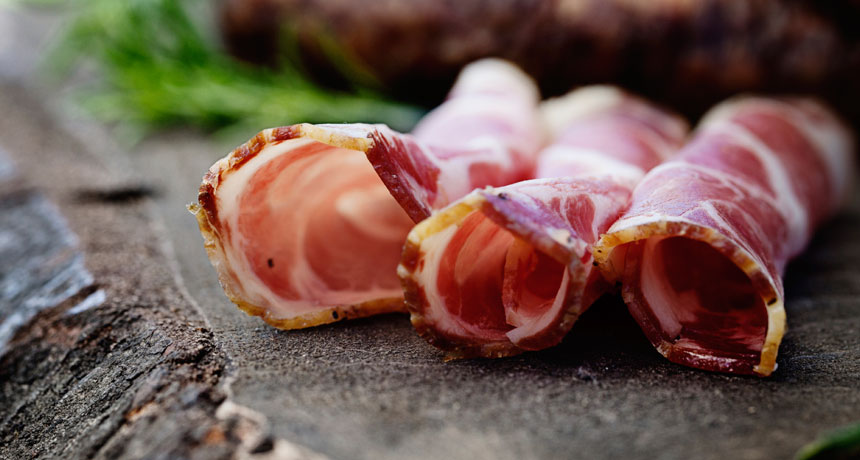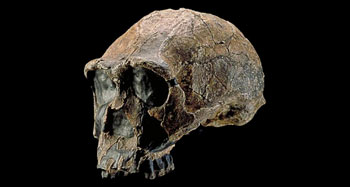Slicing meat may have aided human evolution
The change in diet meant less energy was required for chewing

Sliced meats, usually cooked, are part of many modern diets. But our ancestors may have been eating raw slices. And that could have led to changes in the human body, a new study finds.
mythja/istockphoto
Share this:
- Share via email (Opens in new window) Email
- Click to share on Facebook (Opens in new window) Facebook
- Click to share on X (Opens in new window) X
- Click to share on Pinterest (Opens in new window) Pinterest
- Click to share on Reddit (Opens in new window) Reddit
- Share to Google Classroom (Opens in new window) Google Classroom
- Click to print (Opens in new window) Print
By Bruce Bower
Early members of Homo — the human genus — had a flair for preparing raw sliced meat, a new study suggests. That meaty diet may have literally changed the face of Homo evolution. It also may have enabled advances in talking and walking.
The early human ancestor that used stone tools to slice up raw meat before eating it is known as Homo erectus. These early hominids lived some 1.8 million years ago in Africa and Eurasia. Slicing meat would have made it possible to consume more calories while reducing chewing effort, say Katherine Zink and Daniel Lieberman. They are paleoanthropologists at Harvard University in Cambridge, Mass. They reported their findings online March 9 in Nature.

The shrinkage of bones and muscles involved in chewing also would have affected other parts of the body, these scientists argue. An expanded vocal tract would have boosted the ability of these early ancestors to make speech sounds. And a realignment of the base of the skull would have led to a repositioning of the spinal cord. That led to an increased ability to walk and run long distances.
Zink and Lieberman made their findings through a study of modern-day humans. A total of 34 adults were given measured portions of goat meat or three plants rich in starch. These were jewel yams, carrots and red beetroots. Food came either unprepared, sliced, cooked, or pounded using a stone to soften it.
The volunteers had one job: Chew the food.
The scientists then analyzed how much the face muscles worked and tallied the number of chews needed to ready the different foods for swallowing.
After an average of 40 chews, participants still couldn’t break apart 3-gram (0.1-ounce) chunks of raw goat meat. Cooked chunks were no easier to chew into pieces. Meat sliced from raw, 3-gram (0.1-ounce) chunks, however, required an average of about 31 chews to break into pieces small enough to easily swallow and digest.
The researchers assumed that H. erectus may have gotten one-third of its total calories from sliced meat. The rest would have come from stone-pounded plants, such as those jewel yams. With that ratio, H. erectus would have needed to chew its food 17 percent less and exert 26 percent less force than if only unprepared plants were consumed, the scientists now estimate. Over a year, they calculate, dining on sliced meat could have saved H. erectus more than 2.5 million chews.
Cooking makes it even easier to chew and digest meat and edible plants such as yams, Zink and Lieberman note. But they estimate that our hominid ancestors began to regularly cook food only about 500,000 years ago. Cooking, the researchers say, would have stimulated further jaw and facial shrinkage in Homo sapiens — our species — but not in H. erectus. Instead, they conclude, a taste for sliced, raw meat got those facial changes off to a fast start in H. erectus.
Researchers have long noted that H. erectus skulls display relatively smaller jaws and faces than relatives that preceded the Homo genus more than 2 million years ago.
The new study provides the first evidence for a decades-old assumption that tools for meat-eaters prompted the evolution of smaller faces in early Homo, says Manuel Domínguez-Rodrigo. He works at Complutense University of Madrid, Spain. A paleoanthropologist, he did not work on the new chewing study. “The key is the consumption of sliced meat,” he says. And it, he notes, was “enabled by the use of stone tools.”
H. erectus must have regularly hunted prey to maintain a diet of about one-third meat, Domínguez-Rodrigo adds.
Power Words
(for more about Power Words, click here)
calorie The amount of energy needed to raise the temperature of 1 gram of water by 1 °C. It is typically used as a measurement of the energy contained in some defined amount of food.
digest (noun: digestion) To break down food into simple compounds that the body can absorb and use for growth. Some sewage-treatment plants harness microbes to digest — or degrade — wastes so that the breakdown products can be recycled for use elsewhere in the environment.
Eurasia That part of the globe covered by Europe and Asia.
evolution A process by which species undergo changes over time, usually through genetic variation and natural selection. These changes usually result in a new type of organism better suited for its environment than the earlier type. The newer type is not necessarily more “advanced,” just better adapted to the conditions in which it developed.
genus (plural: genera) A group of closely related species. For example, the genus Canis — which is Latin for “dog” — includes all domestic breeds of dog and their closest wild relatives, including wolves, coyotes, jackals and dingoes.
hominid A primate of an animal family that includes humans and their fossil ancestors.
Homo A genus of species that includes modern humans (Homo sapiens). All had large brains and used tools. This genus is believed to have first evolved in Africa and over time its members continued to evolve and radiate throughout the rest of the world.
Homo erectus An extinct species of hominid that lived in Africa and Eurasia from about 1.9 million to 70,000 years ago.
Homo sapiens The species of hominid to which all living humans belong.
paleoanthropology The study of the culture of ancient people or human-like folk, based on the analysis of remnants, artifacts or markings created or used by these individuals. People who work in this field are known as paleoanthropologists.
prey (n.) Animal species eaten by others. (v.) To attack and eat another species.
spinal cord A cylindrical bundle of nerve fibers and associated tissue. It is enclosed in the spine and connects nearly all parts of the body to the brain, with which it forms the central nervous system.
starch A soft white chemical made by all green plants. It’s a relatively long molecule made from linking together a lot of smaller, identical building blocks — all of them glucose, a simple sugar. Plants and animals use glucose as an energy source. Plants store that glucose, in the form of starch, as a reserve supply of energy. Animals that consume starch can break down the starch into glucose molecules to extract the useful energy.







